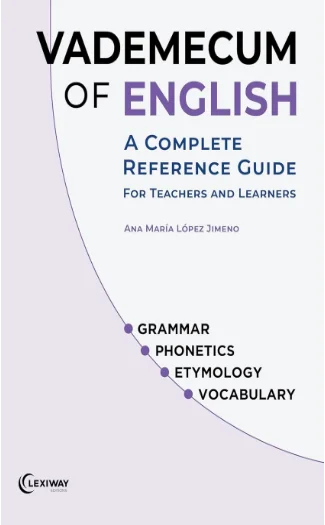Reviewed by Ephantus Gold
If you’ve ever struggled with English (and let’s be honest, who hasn’t?), Ana María López Jimeno’s “Vademecum of English: A Complete Reference Guide for Teachers and Learners” is the book you didn’t know you needed. This isn’t one of those boring grammar books that make you want to sleep after five minutes but rather a guide that feels like having a super smart language coach in your backpack — ready to help whenever English throws its weirdest rules and exceptions at you. Purchase Here.
First, the name “vademecum” — it’s Latin for “come with me,” is a fantastic fit. This book is designed to go with you, like your own personal language companion. Whether you’re stuck on pronunciation, grammar, vocabulary, or even wondering where words come from, it’s got your back. The book’s broken down into four sections: Phonetics, Grammar, Vocabulary, and Etymology. But the brilliance is in how it explains all of this. The author uses tons of easy-to-read charts that help you see the patterns and rules without drowning in endless explanations. You can actually flip to a section and get the answer you need in seconds. It’s basically a cheat code for English class.
The Phonetics part is super helpful if you’ve ever wondered why English sounds so strange — like, why “though,” “through,” and “thought” don’t rhyme. Furthermore, if you speak or are studying Spanish, the section contrasts English with Spanish sounds, which is a useful feature. Next up, the Grammar section which covers all the usual elements (nouns, verbs, pronouns, etc.), but it breaks them down in a way that actually makes sense. Suddenly, things like indirect speech and weird verb tenses feel way less intimidating. The Vocabulary section is awesome because it doesn’t just throw random words at you — it groups over 3,300 words into themes. So instead of memorizing a giant list, you start seeing connections between words, which makes them stick in your brain better. Most readers may find the Etymology section to be their favorite since it allows them to obsess about the origins of words. By revealing that many English words have roots in Spanish, French, Latin, and even Greek, one can quickly identify the roots, prefixes, and suffixes and begin to notice links everywhere. Reading this section is like decoding the secret life of words.
Another thing that makes this book stand out: it’s bilingual. The charts and explanations are in English and Spanish, which is amazing if you’re learning one or the other. Plus, the design is clean, colorful, and not overwhelming, so it’s easy to use without feeling like you’re lost in a textbook jungle. The writing style is clear, concise, and highly practical and the tone is professional yet accessible — it feels like an experienced teacher calmly guiding you, without overwhelming jargon or academic clutter. The author has remarkably used appropriate terminology as well as precise, focused word choice that is easy for non-experts to understand.
“Vademecum of English: A Complete Reference Guide for Teachers and Learners” is the best companion for English language learners, whether they are attempting to go through school, study for tests, or simply wish to appear more intelligent while interacting with friends. It’s practical, it’s fun, and it might just make you fall in love with language (or at least stop hating English). Highly recommend.
